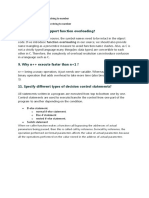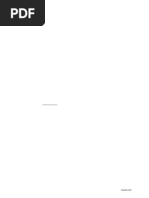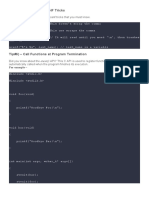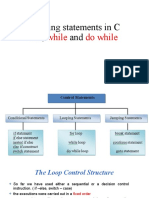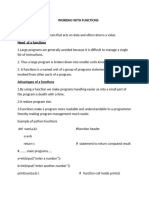0 ratings0% found this document useful (0 votes)
23 viewsLect 07 Control Flow While
Lect 07 Control Flow While
Uploaded by
Teknik Elektro18The document discusses different types of loops in programming like while, do-while, and for loops that allow code to be repeatedly executed based on conditional expressions. It provides examples of how to write these loops in C programming language and when each type of loop is best used. The document also briefly covers control flow statements like break, continue, and goto that can alter the normal sequential execution of code within loops.
Copyright:
© All Rights Reserved
Available Formats
Download as PDF, TXT or read online from Scribd
Lect 07 Control Flow While
Lect 07 Control Flow While
Uploaded by
Teknik Elektro180 ratings0% found this document useful (0 votes)
23 views29 pagesThe document discusses different types of loops in programming like while, do-while, and for loops that allow code to be repeatedly executed based on conditional expressions. It provides examples of how to write these loops in C programming language and when each type of loop is best used. The document also briefly covers control flow statements like break, continue, and goto that can alter the normal sequential execution of code within loops.
Original Description:
bahasa c control flow
Copyright
© © All Rights Reserved
Available Formats
PDF, TXT or read online from Scribd
Share this document
Did you find this document useful?
Is this content inappropriate?
The document discusses different types of loops in programming like while, do-while, and for loops that allow code to be repeatedly executed based on conditional expressions. It provides examples of how to write these loops in C programming language and when each type of loop is best used. The document also briefly covers control flow statements like break, continue, and goto that can alter the normal sequential execution of code within loops.
Copyright:
© All Rights Reserved
Available Formats
Download as PDF, TXT or read online from Scribd
Download as pdf or txt
0 ratings0% found this document useful (0 votes)
23 views29 pagesLect 07 Control Flow While
Lect 07 Control Flow While
Uploaded by
Teknik Elektro18The document discusses different types of loops in programming like while, do-while, and for loops that allow code to be repeatedly executed based on conditional expressions. It provides examples of how to write these loops in C programming language and when each type of loop is best used. The document also briefly covers control flow statements like break, continue, and goto that can alter the normal sequential execution of code within loops.
Copyright:
© All Rights Reserved
Available Formats
Download as PDF, TXT or read online from Scribd
Download as pdf or txt
You are on page 1of 29
CONTROL FLOW
WHILE-DO AND DO-WHILE
AND FOR-LOOP
Why do while and while do
Programs using if statement is sequential
Program will flow from top to bottom and some
blocks are executed based on the condition
This sequential system lacks repetition
An if statement checks if an expression is true or
false, and then runs the code inside the statement
only if it is true. The code inside the loop is only run
once...
A while statement is a loop. Basically, it continues to
execute the code in the while statement for however
long the expression is true.
When to use loop
There are two types of loop:
While-do
Do-while
Loop is best use when you don't know exactly how
many times you may have to loop through a
condition - if you know exactly how many times you
want to test a condition
Loop will go to the previous position as indicated at
the start of the loop
Control flow while-do (1/4)
Example of boiling water
Turn on stove
Put pan on the stove
Look at the water, if not boiling
Repetition
Then wait, go into previous activity Not knowing how long
Turn off stove
Remove pan
Control flow while-do (2/4)
Flow diagram of while do
Control flow while-do (3/4)
Example format of while-do:
while (test expression)
{
modular block to be executed
}
Example of calculating factorial
5! = 5*4*3*2*1
Control flow while-do (4/4)
#include <stdio.h>
int main()
{
int number,factorial;
printf("Enter a number.\n");
scanf("%d",&number);
factorial=1;
while (number>0)
{ /* while loop continues until test condition number>0 is
true */
factorial=factorial*number;
--number;
}
printf("Factorial=%d",factorial);
return (0);
}
Example program
The above program is available on Linux system
Run and try during class
Other program and guessing a number
Name of programs
Random-guess.c
Control-while-do.c
Control flow do-while (1/4)
do...while loop is very similar to while loop
difference between these two loops is that, in while
loops, test expression is checked at first but, in
do...while loop code is executed at first then the
condition is checked
the code are executed at least once in do...while
loops.
Control flow do-while (2/4)
Flow diagram of do-while
Control flow do-while (3/4)
Format of do-while:
do
{
some code/s;
} while (test expression);
Example, adding number :
Ask for a number
Add the number to the sum
Display the result
Ask again, quit if zero
Control flow do-while (4/4)
/*C program to demonstrate the working of do...while statement*/
#include <stdio.h>
int main()
{
int sum=0,num;
do /* Codes inside the body of do...while loops are at least
executed once. */
{
printf("Enter a number\n");
scanf("%d",&num);
sum+=num; /* sum = sum+num;*/
}
while(num!=0);
printf("sum=%d",sum);
return (0);
}
Apa yang terjadi (1/2)
#include <stdio.h>
int main()
{
int factorial=1,number=1;
while (1)
{
factorial=factorial*number;
number++;
}
printf(“Factorial = %d\n“,factorial);
return (0);
}
Apa yang terjadi (2/2)
#include <stdio.h>
int main()
{
int sum=0,num;
do /* Codes inside the body of do...while loops are at least executed
once. */
{
printf("Enter a number\n");
scanf("%d",&num);
sum+=num;
}
while(1);
printf("sum=%d",sum);
return (0);
}
Program example
Program example is the same as the above
example
Name of program is control-do-while.c
Control flow for-loop (1/4)
Loops causes program to execute the certain block
of code repeatedly until some conditions are
satisfied
Loops are used in performing repetitive work in
programming
Suppose you want to execute some codes 100
times, it can be performed by writing that code
once and repeat the execution 100 times using loop
Control flow for-loop (2/4)
Flow diagram of
control flow for-loop
Control flow for-loop (3/4)
Format of for loop:
for(initial expression; test expression;
update expression)
{
code/s to be executed;
}
Example of calculating factorial
5! = 5*4*3*2*1
Control flow for-loop (4/4)
#include <stdio.h>
int main()
{
int number, count, factorial=1;
printf("Enter the value of n.\n");
scanf("%d",&number);
for(count=1;count<=number;++count)
//for loop terminates if count>n
{
factorial *= count; /* this statement is equivalent to
factorial = factorial*count */
}
printf(“Factorial = %d\n“, factorial);
return (0);
}
Control flow goto (1/5)
goto allows you to jump unconditionally to arbitrary
part of your code (within the same function, later
about function).
the location is identified using a label
a label is a named location in the code. It has the
same form as a variable followed by a ’:’
goto statement is used for altering the normal
sequence of program execution by transferring
control to some other part of the program
Control flow goto (2/5)
Go To Statement Considered Harmful
Communications of the ACM 11(3),1968
Excess use of goto creates spaghetti code.
Using goto makes code harder to read and debug.
Any code that uses goto can be written without
using one.
TRY NOT TO USE GOTO AT ANY COST
IT IS NOT A GOOD PROGRAMMING PRACTICE
Control flow goto (3/5)
Flow diagram of goto statement both going
forward and backward
Control flow goto (4/5)
Format of goto:
goto label;
code to be executed;
code to be executed;
label:
codes to be executed;
Control flow goto (5/5)
/* C program to demonstrate the working of goto statement.*/
# include <stdio.h>
void main()
{
float num,average,sum;
int i,n;
printf("Maximum no. of inputs: ");
scanf("%d",&n);
for(i=1;i<=n;++i)
{
printf("Enter n%d: ",i);
scanf("%f",&num);
if(num<0.0)
goto jump; /* control of the program jumps to label jump */
sum=sum+num;
}
jump:
average=sum/(i-1);
printf("Average: %.2f",average);
}
Control flow break (1/2)
Utilized to terminate loop immediately when encountered
for three loops: for, while and do...while
Usually used with conditional if statement
Flow diagram:
Control flow break (2/2)
/* C program to demonstrate the working of break statement by terminating
a loop, if user inputs negative number*/
# include <stdio.h>
int main()
{
float num,average,sum;
int i,n;
printf("Maximum no. of inputs\n");
scanf("%d",&n);
for(i=1;i<=n;++i)
{
printf("Enter n%d: ",i);
scanf("%f",&num);
if(num<0.0)
break; //for loop breaks if num<0.0
sum=sum+num;
}
average=sum/(i-1);
printf("Average=%.2f",average);
return (0);
}
Control flow continue (1/2)
To skip some statements inside the three loops: for,
while and do...while
Usually used with conditional if statement (similar to
break)
Flow diagram
Control flow continue (2/2)
//program to demonstrate the working of continue statement in C
programming
# include <stdio.h>
void main()
{
int i,num,product;
for(i=1,product=1;i<=4;++i)
{
printf("Enter num%d:",i);
scanf("%d",&num);
if(num==0)
continue; / *In this program, when num equals to
zero, it skips the statement product*=num and continue the
loop. */
product*=num;
}
printf("product=%d",product);
}
Try example program
Each all try the programs yourselves
Raise your hand when finished
If you have problems, also raise your hand
Assignment prime number:
A Prime Number can be divided evenly only by 1, or itself
First prime number is ‘2’ and the only even prime number
Other prime numbers will always be odd numbers
Check the prime candidate by dividing the candidate by odd
numbers until candidate/2
Write a program to check prime number
Write a program to find the first 10 prime numbers
Expand program to find the first 10000 prime numbers
Fastest program will win a small price
You might also like
- CS 101 Lecture 3 PDFDocument35 pagesCS 101 Lecture 3 PDFMohammad ArafatNo ratings yet
- Clrs Solution CollectionDocument217 pagesClrs Solution CollectionbrzeczkaNo ratings yet
- Unit 2 Final NotesDocument92 pagesUnit 2 Final Noteshrutujaumratkar123No ratings yet
- C.Module 03Document7 pagesC.Module 03SM Manzoor MurshedNo ratings yet
- C ProgrammingDocument22 pagesC ProgrammingGaneshanNo ratings yet
- Structured Programming Language: The LoopDocument53 pagesStructured Programming Language: The LoopShahed HossainNo ratings yet
- Lecture FiveDocument18 pagesLecture FivealvinmwangisirNo ratings yet
- LoopingDocument30 pagesLoopingsakshamsingh13617No ratings yet
- Unit-2 PSWCDocument14 pagesUnit-2 PSWCappikondaroopavardhan135No ratings yet
- Construct 3 - Repetition / Looping by Prof. Elijah Omwenga October 2012Document25 pagesConstruct 3 - Repetition / Looping by Prof. Elijah Omwenga October 2012millerNo ratings yet
- Unit 1Document29 pagesUnit 1ashishadicted4No ratings yet
- C Programming While and DoDocument3 pagesC Programming While and DoslspaNo ratings yet
- CP Chapter 2Document30 pagesCP Chapter 2Birju PrajapatiNo ratings yet
- Iterative StatementsDocument31 pagesIterative StatementsFrancis Gutierrez BalazonNo ratings yet
- Sanskrit Ist SemisterDocument23 pagesSanskrit Ist Semistershivanandhnandh40No ratings yet
- Ip Iy Iis Unit 2Document13 pagesIp Iy Iis Unit 2Srinivas Kumar PalvadiNo ratings yet
- Assignment C++ Programming: Syntax of Goto StatementDocument10 pagesAssignment C++ Programming: Syntax of Goto StatementMohd FahmiNo ratings yet
- Assignment C++Muhamad Nur AqmalDocument11 pagesAssignment C++Muhamad Nur AqmalMuhamad Nur AqmalNo ratings yet
- Do While LoopDocument3 pagesDo While LoopAshfaq KhanNo ratings yet
- CP LabDocument25 pagesCP LabShreya GokhaleNo ratings yet
- 3 ProgrammingDocument22 pages3 ProgrammingkamirualexNo ratings yet
- Looping Construct in C LanguageDocument24 pagesLooping Construct in C LanguagebastiNo ratings yet
- LoopingDocument8 pagesLoopingbikashbogati001No ratings yet
- Why Doesn't C Support Function Overloading?Document17 pagesWhy Doesn't C Support Function Overloading?PEPETI RAVINo ratings yet
- Unit 3 (Softcopy)Document32 pagesUnit 3 (Softcopy)sanyamkumar75No ratings yet
- For (Initial Value Condition Incrementation or Decrementation) (Statements )Document7 pagesFor (Initial Value Condition Incrementation or Decrementation) (Statements )Shivraj Kumar ChhetriNo ratings yet
- Control Statements (Looping) While-Do While and ForDocument27 pagesControl Statements (Looping) While-Do While and ForMab AbdulNo ratings yet
- Iterative StatementsDocument14 pagesIterative Statementssavagegamer1289No ratings yet
- Looping Control StructuresDocument29 pagesLooping Control Structuresmanavjpatel2006No ratings yet
- More Control StatementsDocument14 pagesMore Control StatementsayushiarchakNo ratings yet
- CTU 07103 Programming App & Info Sec - Session 3 - Control FlowDocument22 pagesCTU 07103 Programming App & Info Sec - Session 3 - Control FlowLaurent KalugulaNo ratings yet
- Chap 5 LoopingDocument22 pagesChap 5 LoopingblandonashimirweNo ratings yet
- The Decision Control StructureDocument42 pagesThe Decision Control StructureAmir AmirthalingamNo ratings yet
- Branching and Looping ProgramsDocument12 pagesBranching and Looping ProgramspubgnewstatemobiletestNo ratings yet
- PPS - Ch-6.Control Structure in CDocument45 pagesPPS - Ch-6.Control Structure in C2203051050594No ratings yet
- Labsheet 5Document15 pagesLabsheet 5saurabharpitNo ratings yet
- Conditional StatementDocument11 pagesConditional StatementHema MaliniNo ratings yet
- For Loop - 1Document9 pagesFor Loop - 1Edwin OdhiamboNo ratings yet
- Control StatementsDocument17 pagesControl Statementsyatendra kashyapNo ratings yet
- LM - Unit4 2Document8 pagesLM - Unit4 2raisinghdaksh2No ratings yet
- Unit 2Document32 pagesUnit 2a28657798No ratings yet
- ITC LAB 11 - For LoopDocument4 pagesITC LAB 11 - For LooppathwayNo ratings yet
- 10-DoWhile-Infinit-Cont-Function-After MidDocument10 pages10-DoWhile-Infinit-Cont-Function-After MidSaifNo ratings yet
- 5 LoopsDocument46 pages5 Loopssium1111111No ratings yet
- While Loop 2. For Loop 3. Do While Loop: Practice The Following Concepts in This LabDocument8 pagesWhile Loop 2. For Loop 3. Do While Loop: Practice The Following Concepts in This LabM UmAr ArshAdNo ratings yet
- Assignment C++ PDFDocument15 pagesAssignment C++ PDFnurul shamieza33% (3)
- Lecture 8,9Document60 pagesLecture 8,9deveshsingh20666No ratings yet
- Tip#5) - Some Cool SCANF Tricks: Find Out Some of The Unheard Scanf Tricks That You Must KnowDocument17 pagesTip#5) - Some Cool SCANF Tricks: Find Out Some of The Unheard Scanf Tricks That You Must KnowGauri BansalNo ratings yet
- C Programming Break and Continue StatementDocument4 pagesC Programming Break and Continue StatementslspaNo ratings yet
- For Loop ES081 PART BDocument21 pagesFor Loop ES081 PART BDavid AlingasaNo ratings yet
- C ProgrammingDocument54 pagesC ProgrammingNitin KhannaNo ratings yet
- Cse 122Document3 pagesCse 122Shamima HossainNo ratings yet
- uyrtazdhbDocument10 pagesuyrtazdhbnoelgladson7No ratings yet
- For Loop in CDocument38 pagesFor Loop in CHarsh RawaleNo ratings yet
- C LoopsDocument5 pagesC LoopsMr. RAVI KUMAR INo ratings yet
- c basic6Document8 pagesc basic6jasimshanto20215No ratings yet
- Lab 4 RepetitionDocument5 pagesLab 4 RepetitionjscansinoNo ratings yet
- Taylor SeriesDocument6 pagesTaylor SeriesAtharva SinghNo ratings yet
- Lecture 2.1.3 Jump StatementsDocument16 pagesLecture 2.1.3 Jump Statementssiyalohia8No ratings yet
- Ramirez Lab05Document26 pagesRamirez Lab05Nerisse Allyztair RamirezNo ratings yet
- DATA SCIENCE Using R NotesDocument116 pagesDATA SCIENCE Using R Notes32. MANKHUSH KUMARNo ratings yet
- Computer ProgrammingDocument98 pagesComputer ProgrammingMUNIB CHOHANNo ratings yet
- Lectures: 1 To 6: Assignment No. 1Document2 pagesLectures: 1 To 6: Assignment No. 1m umairNo ratings yet
- Chapter 6 FunctionsDocument92 pagesChapter 6 FunctionshonkytonkzNo ratings yet
- Python-PyCharm TutorialDocument61 pagesPython-PyCharm Tutorialthuan.dang3103No ratings yet
- C# - 1Document21 pagesC# - 1Ikawa AfueNo ratings yet
- Module-6 Repetition LoopingDocument6 pagesModule-6 Repetition LoopingjunNo ratings yet
- Python - 2 Marks Question BankDocument17 pagesPython - 2 Marks Question Bankrajesh93601615No ratings yet
- Chapter 5 Study QuestionsDocument17 pagesChapter 5 Study QuestionsJohn HeilNo ratings yet
- Dbms Unit 4 PLSQLDocument26 pagesDbms Unit 4 PLSQLGRASH KJTNo ratings yet
- Proving The Correctness of Algorithms: Algorithm Design and AnalysisDocument35 pagesProving The Correctness of Algorithms: Algorithm Design and AnalysisRaduNo ratings yet
- C QuestionsDocument12 pagesC QuestionsSivaprakasam KarthikeyanNo ratings yet
- Looping in PythonDocument10 pagesLooping in PythonDhivya Bharathi pNo ratings yet
- Exam Dumps 2018 PDFDocument12 pagesExam Dumps 2018 PDFAlessandro AvoliNo ratings yet
- Notes - Working With FunctionsDocument13 pagesNotes - Working With Functionsdhruvbharadwaj883No ratings yet
- Assignment - 2: Nuzaiff Ather 27181 Bscs - 4 CDocument9 pagesAssignment - 2: Nuzaiff Ather 27181 Bscs - 4 CFalak MalikNo ratings yet
- Manual Python: 1. Whetting Your AppetiteDocument152 pagesManual Python: 1. Whetting Your Appetiteromel huaraca poccoNo ratings yet
- PPL 1Document17 pagesPPL 1sathish_arukonda9462No ratings yet
- Ics 2104 Object Oriented Programming IDocument2 pagesIcs 2104 Object Oriented Programming Inaomi.amadiNo ratings yet
- Apollo JavaDocument211 pagesApollo Javavikasmoni084No ratings yet
- Unit 1 CS3353 - C Programming and Data StructuresDocument6 pagesUnit 1 CS3353 - C Programming and Data StructuresKokila S100% (2)
- MSBTE Solution App-1 PDFDocument186 pagesMSBTE Solution App-1 PDFOjaswini BorseNo ratings yet
- Network Programmability Foundation PDFDocument141 pagesNetwork Programmability Foundation PDFkongarajaykumarNo ratings yet
- B SC-CS PDFDocument21 pagesB SC-CS PDFHemavathi JNo ratings yet
- PPS Chapter-5Document22 pagesPPS Chapter-5Viral PanchalNo ratings yet
- The Python MasterDocument192 pagesThe Python Mastervivekpandeyscribd100% (5)
- Constructors in JavaDocument18 pagesConstructors in JavaAmol AdhangaleNo ratings yet
- 6-A Closer Look at Classes and Methods-1Document22 pages6-A Closer Look at Classes and Methods-1aakarsh204No ratings yet
- Java Exercises On MethodsDocument4 pagesJava Exercises On MethodsMan RunnerNo ratings yet























